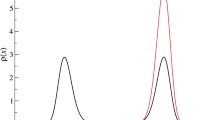Abstract
The problem on minimization of the thermodynamic action performed by a linear relaxing thermodynamic system from an arbitrary nonequilibrium state on a finite time interval has been solved. In specific applications, this problem solves that on the maximum mechanical or electric energy (work) which can be recovered in a finite time interval from such systems as a viscoelastic body, electric RC and LC circuits, an ideal gas with relaxation, and others in an arbitrary nonequilibrium initial state.
Similar content being viewed by others
References
F. L. Curzon and B. Ahlborn, Efficiency of a Carnot engine at maximum power output, Amer. J. Phys., 43, 22–24 (1975).
L. M. Rozonoér and A. M. Tsirlin, Optimum control over thermodynamic processes, Avtomat. Telemekh., No. 1, 70–79; No. 2, 88–101; No. 3, 50–64 (1983).
V. N. Orlov and A. V. Rudenko, Optimum control in the problems of limited possibilities of thermodynamic processes, Avtomat. Telemekh., 46, 7–39 (1985).
V. T. Borukhov and A. I. Shnip, Thermodynamic theory of relaxing systems, in: Proc. IV Minsk Int. Forum “Heat and Mass Transfer-MIF-2000" [in Russian], 22–26 May 2000, Vol. 3, Minsk (2000), pp. 151–158.
A. I. Shnip, Theory of generalized thermodynamic systems with memory, Inzh.-Fiz. Zh., 75, No. 1, 21–31 (2002).
R. E. Kalman, P. L. Falb, and M. A. Arbib, Topics in Mathematical System Theory, McGraw-Hill, New York (1969).
J. Willems, Realization of systems with internal passivity and symmetry constraints, J. Franklin Inst., 301, No. 6, 605–621 (1978).
S. Breuer and E. T. Onat, On recoverable work in linear viscoelasticity, ZAMP, 15, No. 2, 12–21 (1964).
V. T. Borukhov, V. L. Kolpashchikov, and A. I. Shnip, Linear thermodynamic systems with memory. III. Theory of thermodynamic nonequilibrium potentials, Inzh.-Fiz. Zh., 69, No. 5, 707–715 (1996).
V. L. Borukhov and A. I. Shnip, Subordinated systems and dissipative inequality for linear finite-dimensional passive systems, System Sci., 25, No. 4, 15–24 (1999).
B. D. Coleman and M. E. Gurtin, Thermodynamics with internal state variables, J. Chem. Phys., 47, No. 2, 597–613 (1967).
D. Bland, Theory of Linear Viscoelasticity, Pergamon Press, London (1960).
B. D. Coleman and D. R. Owen, A mathematical foundation for thermodynamics, Arch. Rat. Mech. Anal., 54, No. 1, 1–102 (1974).
V. L. Kolpashchikov and A. I. Shnip, Thermodynamic constraints of constitutive equations in thermoviscoelasticity: New interrelations of cross effects, Prikl. Mat. Mekh., 59, No. 1, 280–289 (1995).
Author information
Authors and Affiliations
Additional information
__________
Translated from Inzhenerno-Fizicheskii Zhurnal, Vol. 78, No. 6, pp. 3–13, November–December, 2005.
Rights and permissions
About this article
Cite this article
Shnip, A.I. Maximum work of relaxing systems recoverable in a finite time. J Eng Phys Thermophys 78, 1047–1058 (2005). https://doi.org/10.1007/s10891-006-0034-0
Received:
Issue Date:
DOI: https://doi.org/10.1007/s10891-006-0034-0



